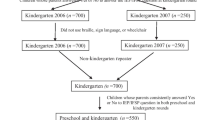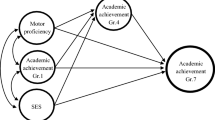Abstract
The effects of latchkey status on the normal development of children are poorly addressed in the literature. After formulating an operational definition, the prevalence, academic performance, and behavior characteristics of latchkey children were investigated in a rural area. Few differences were found to distinguish latchkey from nonlatchkey children.
Similar content being viewed by others
References
Achenbach, T. M. & Edelbrock, C. (1983).Manual for the Child Behavior Checklist. Burlington, VT: University of Vermont, Department of Psychiatry.
Achenbach, T. M. & Edelbrock, C. (1986).Manual for the Teacher's Report Form and teacher version of the Child Behavior Profile. Burlington, VT: University of Vermont, Department of Psychiatry.
Achenbach, T. M. & Edelbrock, C. (1987).Manual for the Youth Self Report. Burlington, VT: University of Vermont, Department of Psychiatry.
American Psychiatric Association. (1980).Diagnostic and statistical manual of mental disorders III. Washington: American Psychiatric Press.
Bunch, M. B. (1985). California Achievement Tests, Forms C & D. In D. Keyser & R. Sweetland (Eds.),Test critiques: Vol. 3. (pp. 111–124). Kansas City: Test Corporation of America.
Cain, V. S. & Hofferth, S. L. (1987, May).Parental choice of self-care for school-age children. Paper presented at the annual meeting of the Population Association of America, Chicago, IL.
Fosarelli, P. D. (1984). Latchkey children.Journal of Developmental and Behavioral Pediatrics, 5, 173–177.
Galambos, N. L., & Garbarino, J. (1982).Identifying the missing links in the study of latchkey children. ERIC ED 222 273.
Galambos, N. L. & Garbarino, J. (1985). Adjustment of unsupervised children in a rural setting.Journal of Genetic Psychology, 146, 227–231.
Gold, D., & Andres, D. (1978). Developmental comparisons between ten year old children with employed and non-employed mothers.Child Development, 49, 75–84.
Hoffman, L. W. (1974). Effects of maternal employment on the child: a review of the research.Developmental Psychology, 10, 204–228.
Kelly, P. C., Weir, M. R., Atkinson, A. W., Lampe, R. M., Schydlower, M., & Fearnow, R. G. (1986). “Latchkey” three voices with one message.Clinical Pediatrics, 25, 462–465.
Long, T. J., & Long, L. (1981).Latchkey children: The child's view of self care. ERIC ED 211 229.
Long, T. J., & Long, L. (1983).Latchkey children. ERIC ED 226 836.
McMurray, G., & Kazanjian, D. (1982).Day care and the working poor: The current struggle for self-sufficiency. ERIC ED 221 266.
Offord, D. R., Boyle, M. H., & Jones, B. R. (1987). Psychiatric disorder and poor school performance among welfare children in Ontario.Canadian Journal of Psychiatry, 32, 518–525.
Robinson, B. E., Rowland, B. H. & Coleman, M. (1986).Latchkey kids, unlocking doors for children and their families. Lexington, MA: D. C. Heath.
Rodman, H., Pratto, D. J., & Nelson, R. S. (1988). Child care arrangements and children's functioning: A comparison of self care and adult care children.Developmental Psychology, 21, 413–418.
Steinberg, L. (1986). Latchkey children and susceptibility to peer pressure: An ecological analysis.Developmental Psychology, 22, 433–439.
Stewart, M. (1981).Children in self-care: An exploratory study. ERIC ED 224 604.
Strother, D. B. (1986). Latchkey children: The fastest growing special interest group in the school.Journal of School Health, 56, 13–16.
Wallston, B. (1973). The effects of maternal employment on children.Journal of Child Psychology and Psychiatry, 14, 81–95.
Woods, M. D. (1972). The unsupervised child of the working mother.Developmental Psychology, 6, 14–25.
Author information
Authors and Affiliations
Additional information
This research was funded partially by a grant from the United Way.
Rights and permissions
About this article
Cite this article
Diamond, J.M., Kataria, S. & Messer, S.C. Latchkey children: A pilot study investigating behavior and academic achievement. Child Youth Care Forum 18, 131–140 (1989). https://doi.org/10.1007/BF01184760
Issue Date:
DOI: https://doi.org/10.1007/BF01184760




